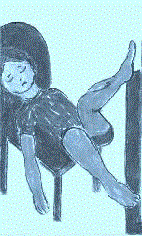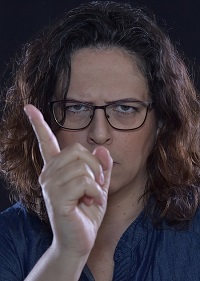





THE CHILD WITH SEVERE LEARNING DIFFICULTIES:
1. objects used as natural type 2 symbols:
a. body parts
J. R. LOCKING & I. J. LOCKING
Published: April 13 2000
Updated: 1 July 2006
SUMMARY
A small percentage of mentally handicapped or 'autistic' children
are in the habit of looking at their hands, a behaviour which I will call
hand regarding behaviour or h.r.b. Cases showing this
behaviour were studied and the following tentative conclusions emerged:
a. The behaviour is symbolic, and it is symbolic of an
emotional encounter with a parent, (or parent figure).
b.These encounters are of two opposite emotional types, with the child
expressing affection, or aggression.
c. These reactions are triggered by current and corresponding actions by
a parent figure, where the adult either shows affection to the child,
or satisfies the child's needs in some other way, or
reprimands the child, or frustrates one of his needs in some
other way.
This behaviour, h.r.b., is related to more extreme symbolic responses
to the child's own hands, and indeed to other parts of his body, and
also to reactions to inanimate objects. In related actions on the
child's hands we may see more extreme and physical responses such as
kissing the hands, or biting them. These reactions might
be called hand directed behaviour, or h.d.b.
These conclusions are, of course, also hypotheses to be tested in
future research.
INTRODUCTION
|
What we are referring to here are those symbolic uses of body
parts which the child unconsciously adopts in certain situations
when interacting with other people.
The word 'natural' in the title excludes |
c) low-level neurological phenomena such as the 'flapping'
movement of the upper limbs, a result of a combination of a
minimal and usually sub-clinical U.M.N. (upper motor neurone)
disorder and excitement. |
experiences where he saw this object being used to open and start the car, whereupon followed his experience of a trip to the shops. Accordingly we will call the symbols we are discussing here type 2 symbols, and those figuring most prominently in t.r.a. as type 1 symbols. Type 1 symbols, in t.r.a., are importantly involved in communicating with other people, about everyday matters, while type 2 symbols, discussed here, are mainly involved in fantasy, wish fulfilling processes, possibly closely related to what are described by the psychoanalysts as the primary process. Only secondarily might they have a role in communicating with other people, in what might be termed a sort of secondary gain , to use another psychoanalytic term. An example of this might be the child who bites his hand very close to, and in front of an adult, in a sort of threat display. Naturally, should the adult then allow the child what had prompted his hand biting , e.g. the denial of something he had wanted , e.g. not to be asked to do something , the behaviour is rewarded and its occurrence becomes more probable. |
OBSERVATIONS - CASES.
|
CASE A DATE: 24.7.93 AGE: 10 SEX: F NAME : J. W.
|
K.W. engages in these behaviours: |
CASE C |
INTERPRETATION
|
In these cases the hand in the flat, spread fingers or claw
shape seems to represent a person, the palm and fingers
symbolising the face and hair respectively. More specifically the
representation seems to be of a parent or parental figure. |
mutilation is probably most common where a
rejecting , turning away of the parent figure would, in the
child's mind, merit a more severe retaliatory aggressive act than
would an angry rebuke, possibly precipitating a physical attack
in reality, or a symbolic one in fantasy, i.e. biting the back of
the hand. |
she
need fear no retaliation. Perhaps if one could show that one
understands the 'message' then this may be regarded as a true,
intentional , deliberate and conscious communication between two
people. In the fantasised continuation of the beginning, which is
a typical interaction between mother figure and daughter in
reality, a different conclusion can be arrived at; reality is
modified to be nearer to J.'s heart's desire. Rather than comply
with the authority figure's order , (as J. actually does), she
will get her own way, she will gain the upper hand over the
parental figure, she will outface her and be triumphant. |
DISCUSSION
|
J. and G.H. illustrate quite clearly the two distinct
varieties of this behaviour, J. exhibits type I and G.H. type II.
A number of questions logically arise: |
This symbolises an
aggressive attack on her mother, especially on her child-bearing
abilities. In this case meaning is even clearer because these
plant and flower pots contain earth in which living things develop
and grow. |
With a drive that is strong , though not necessarily unusually
so, plus a lack of inhibitory controls and selectivity over the
expression of the drive, (factors with social and aesthetic
determinants), we expect attempts to satisfy desires in socially
unacceptable situations with very inappropriate objects. Pica and
public masturbation are indeed witnessed, the drives here being
obviously hunger and sex respectively.
A number of factors could
be responsible for these drives, e.g.:- |
Further discussion.
|
The development of nervous control in an infant's body is
cephalo-caudal and proximo-distal, i.e. |
The child is in this manner facilitated in its
semi-disassociation of these distal organs and their consequent
symbolic application, due to that diminished sense of I-ness
associated with more distal portions of its anatomy, that we have
previously alluded to as being most symptomatic of this
functional level. |
Note some other signs connected with this part of the body
(head): i.e. think, know, believe, clever, silly, mad, forget and
remember etc. |
Additional.
|
More recently G.H., during affectionate interactions, has
involved the hands of the affection-giver, grasping them and
smiling at their palms. This seems to represent a healthier state
of mind, as does the externalisation of some of her aggression.
These factors indicate a less self-absorbed, more socially aware
state and a less self-negative intro-punitive attitude
respectively. The involvement of the affection-giver's hands
might represent a transitional stage in the child's acceptance of
the adult as a parent figure. |
In the years I have known these children, none of them seems to
have changed noticeably their type of behaviour towards their
symbolic hand object(s). However, with some of them, the
direction of their aggression has become less polarised. For
example G.H. originally demonstrated purely self-directed
aggression, but has now begun to show aggression to others . |
B.S.'s head slapping is rather 'superficial' and motivated by a
desire for attention, sympathy and concern. In the absence of an
audience it quickly stops. With G.H. her self-aggression seems
much more the result of a real desire to injure herself. |
G.H.
| A. actual attitude and responses to self and others. | a. later, began to hit others. b.1 previously used
to hit herself, only or mainly. |
| B. hand symbol behaviour. | a. 0 b. 1 gazes fondly at her hand. |
| A. actual attitude and response to self and others. | a. attacks others, pulls their hair, (not their core
self). b. 1 hits self on head. |
| B. hand symbol behaviour | a. 0 b. 1 gazes fondly at his hand. |
| A. actual attitude and responses to self and others. | a. 1 used to hit other people, (on head). b. 0 never hit her real, basic self but pulled her hair = the other. |
| B. hand symbol behaviour | a. 1 stares crossly at her hand(s). b. 0 doesn't
smile or look fondly at her hand(s). |
| A. actual attitude and responses to self and others. | a. 1 hits others, (and his hand = the other). b. 1 hits his chin, with his hand. |
| B. hand symbol behaviour. | a. 1 stares crossly at hand. b. 1 looks fondly on it. |
Appendix II
| Individual A | Individual B | ||
| Inner Core Self, e.g. face, temple, forehead and chin. | Outer Self, e.g. hair and head. | Outer self, e.g. hair and hand. | Inner Core Self, e.g. face, temple, forehead and chin. |
The above diagram expresses a view of the situation that may
cover all the observed facts. We may see the outer parts of
persons as closer together, literally and figuratively, (i.e.
more similar) and the behaviour of a person directed to these,
their own outer parts or the outer parts of another, as more
similar than one might imagine. Aggression by individual A on A,
on his core self, may be seen as much more removed and much more
dissimilar to aggression by A on B's core self.